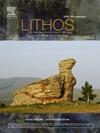Variable onset of magma segregation controls contrasting geochemical patterns of mineral assemblages in fractionating alkaline volcanic systems
IF 2.9
2区 地球科学
Q2 GEOCHEMISTRY & GEOPHYSICS
引用次数: 0
Abstract
Three occurrences of primitive, alkaline, SiO2-undersaturated, volcanic rocks from SW Germany show coarse-grained, mm- to cm-thin veinlets and pockets of differentiated lithologies that are a missing link in an evolutionary trend towards phonolites. (1) In the Hegau region (Hohenstoffeln), melilite-bearing olivine nephelinite contains ijolite pockets with skeletal perovskite, titanomagnetite, and euhedral fluorapatite. (2) Compositionally similar olivine melilitite at Urach (Sternberg) is crosscut by ijolite veinlets with late-magmatic lileyite and wadeite, in which subhedral–euhedral titanomagnetite and perovskite lack a skeletal shape. (3) Nepheline syenitic domains in a phlogopite-nepheline basanite from the Kraichgau region (Steinsberg) contain less clinopyroxene, titanomagnetite, and apatite, but accessory titanite. Differences between the fractionation products partly result from variable host magma compositions. However, the exact starting point of residual melt separation was the key factor explaining the trace element evolution of late mineral phases. Under conditions of advanced clinopyroxene crystallization and perovskite saturation (Urach), massive trace element fractionation led to high Nb/Ta and Zr/Nb, but low LREE/HREE and Zr/Hf ratios in clinopyroxene and perovskite. High F contents contributed to the stabilization of LILE, Zr, and Hf in the enriched residual melt which finally caused crystallization of an agpaitic assemblage. In contrast, melt separation before perovskite saturation (Hegau) resulted in strong, uniform enrichment of LILE, HFSE, and REE in clinopyroxene and perovskite. The nepheline syenite (Kraichgau) underwent a similar evolution with incompatible element enrichment in clinopyroxene and titanite, although its mineral assemblage differs from the ijolites due to higher SiO2 and H2O but lower F and P concentrations in the melt.
岩浆偏析的不同起始控制着分选碱性火山系统矿物组合的地球化学模式
德国西南部的三处原始碱性、sio2欠饱和火山岩显示出粗粒度、毫米至厘米细的细脉和分化的岩性袋,这是向空纹岩演化趋势中缺失的一环。(1)在Hegau地区(Hohenstoffeln),含镁白云石的橄榄云母中含有钙钛矿、钛磁铁矿和自形氟磷灰石的铁闪石袋。(2) Urach (Sternberg)地区的橄榄石镁云母与晚岩浆期的橄榄云母和威德铁矿组成相似,其中亚面形自面形钛磁铁矿和钙钛矿缺乏骨架状。(3) Kraichgau地区(Steinsberg)辉云母—霞石玄玄岩中斜辉石、钛磁铁矿和磷灰石的正长结构域含量较少,但含有副钛矿。分选产物之间的差异部分是由于寄主岩浆成分的不同造成的。而残熔体分离起始点的精确是解释晚期矿物相微量元素演化的关键因素。在斜辉石超前结晶和钙钛矿饱和(Urach)条件下,大量微量元素分馏导致斜辉石和钙钛矿中Nb/Ta和Zr/Nb较高,LREE/HREE和Zr/Hf较低。高F含量有助于LILE、Zr和Hf在富集的残熔体中的稳定,最终导致沉淀组合的结晶。相比之下,钙钛矿饱和(Hegau)前的熔体分离导致斜辉石和钙钛矿中LILE、HFSE和REE的强烈、均匀富集。霞石正长岩(Kraichgau)也经历了类似的演化过程,在斜辉石和钛矿中富集不相容的元素,但其矿物组合与伊绿岩不同,因为熔体中SiO2和H2O含量较高,而F和P含量较低。
本文章由计算机程序翻译,如有差异,请以英文原文为准。
求助全文
约1分钟内获得全文
求助全文
来源期刊

Lithos
地学-地球化学与地球物理
CiteScore
6.80
自引率
11.40%
发文量
286
审稿时长
3.5 months
期刊介绍:
Lithos publishes original research papers on the petrology, geochemistry and petrogenesis of igneous and metamorphic rocks. Papers on mineralogy/mineral physics related to petrology and petrogenetic problems are also welcomed.
 求助内容:
求助内容: 应助结果提醒方式:
应助结果提醒方式:


